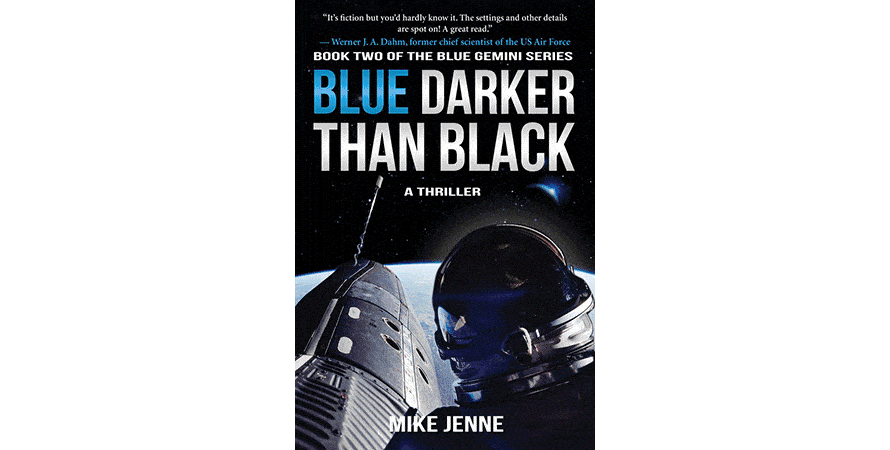Category: Fiction
Reviewed by Clifford R. McMurray
Title: Blue Darker than Black
Author: Mike Jenne
NSS Amazon link for this book
Format: Hardcover, Paperback, Kindle, audiobook
Pages: 556
Publisher: Yucca
Date: January 2016
Retail Price: $24.99/16.99/12.99
ISBN: 978-1631580666
This novel is the second book of an alternate history trilogy, chronicling the lives of two pilots in a secret Air Force program called Blue Gemini. Running in deep cover from an isolated launch site in the Pacific, during the same timeframe as the Apollo flights, Blue Gemini is using modified Gemini capsules to intercept Soviet spacecraft suspected of being orbital nuclear warhead platforms. The first volume ended with our unlikely duo—engineer and trajectory Jedi Scott Ourecky and hotshot fighter pilot Drew Carson—home from their first successful orbital mission, carrying photos of a new type of Soviet spy satellite (see the review of Blue Gemini).
The Blue Gemini program managers were counting on a more sophisticated onboard computer, capable of doing rapid trajectory calculations on the fly to make the quick orbital intercepts work. We now learn that the computer has run into development delays, and Ourecky turns out to be the only flight engineer in the small Blue Gemini cadre who can handle the paper-and-pencil math quickly enough to make the intercepts without it. The other Blue Gemini crew just doesn’t have the chops to get the job done. Instead of a regular rotation, Carson and Ourecky find themselves flying all the Blue Gemini missions at a grueling pace. So much time away from home without being able to say why puts a killing strain on Ourecky’s young marriage. And that’s before he winds up half-dead in the hospital with injuries he can’t discuss with his wife, suffered in a crash landing in Haiti.
Jenne’s first book in this trilogy had trouble with pacing and characterization, as one would expect in a first novel. In this second volume these flaws have mostly been fixed. The pace is faster, the characters more developed. As with techno-thrillers of this size, the cast of characters is large and changing. New characters (an Army special ops agent, and the Russian cosmonauts who are going to wind up as crew on that orbiting nuclear bomb platform in the next book) enter, stage left. One character exits, stage right (prison). Another character exits, stage dead. Covert agents are recruited and eliminated. It’s a big canvas Jenne is painting, but his brush strokes are becoming more sure.
The climax of this volume is an orbital rescue. The Manned Orbiting Laboratory (MOL) program, a military space station cancelled publicly in 1969, turns out to have morphed into a black intelligence program, taken over by the Navy. The first MOL crew has had the bad luck to get caught in a solar flare, and they fall out of contact with the ground. Clearly, they are incapacitated, maybe even dead. It falls to Ourecky and Carson to try to rescue them; they have just a few days to train for the rescue, and when they reach the MOL Ourecky has a dangerous spacewalk to perform to get aboard.
This trilogy is “hard” science fiction, with care taken to get the technical details right. It all reads as if it really happened. I’m impatient to read the concluding volume, Pale Blue, to find out if Ourecky’s marriage survives—or, for that matter, whether he and Carson survive. Clearly, there’s an orbiting nuclear bomb in their future.
© 2019 Clifford R. McMurray
Please use the NSS Amazon Link for all your book and other purchases. It helps NSS and does not cost you a cent! Bookmark this link for ALL your Amazon shopping!




















1 thought on “Book Review: Blue Darker than Black”
Be prepared for tears in the last book.